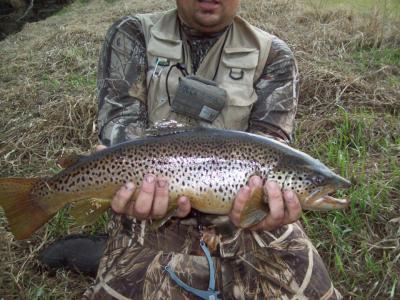
We’ve all seen pictures of monster Brown Trout caught out of the Driftless Region, and wonder how in the world could a trout get THAT big in a Driftless Region Stream.
That was one of the topics covered in the 5th annual Driftless Area Symposium last month. William French from the University of Minnesota gave presentations on winter trout feeding habits and cold water insects.
Very little is known about winter habits of trout. Because most of the Driftless Region is not fish-able due to regulations people don’t really observe trout habits. People focus on spring, summer and fall habits because it best pertains to their fishing preferences and knowledge.
French’s research covered winter life of a Driftless Stream from February to March. They used streams based on three categories: Slow, fast, and average streams (reflecting to trout growth); then they selected 4 streams of each of the respective categories. The crew would tag individual fish through out Minnesota and measure them three times. The crew also investigated food preferences for the trout during the winter months.
During the winter, stream dynamics change from colder water at the mid section and warmer water at the head waters and base waters to the polar opposite for warmer water in the mid section and cooler water in the head and base waters as springs tend to produce warmer water heated up by geo thermal heat. In the summer, air warm up the surface water and the springs produce water at below ground temperatures.
The crew noted trout growth in all the streams and winter trout feeding habits are based on insect availability. During the winter insects that have evolved to withstand colder water temperatures occur seasonally, and the trout capitalize on the hatches or availability of the seasoned insect.
Streams like the Pine River and Elk Creek in South Central Wisconsin and Hay Creek in Minnesota produce larger fish because the water temperatures are higher and they are prone to produce more insect life and winter food to enhance winter growth. Winters over the last couple years have been unseasonably warm, allowing streams to be warm and producing an increase of winter insects.
Streams like Timber Coulee Creek in Wisconsin are traditionally cooler and are less prone to produce significant insect activity and produce smaller fish due to slower growth rates. Another factor of trout growth is genetics. Stock strain trout tend to be smaller than wild strain trout. French’s research isn’t over. The crew plans on studying 36 streams over the next 12 years.
Overall, winter trout do not suffer. Trout feed, grow and flourish in the harsh winters of the Driftless Area.
